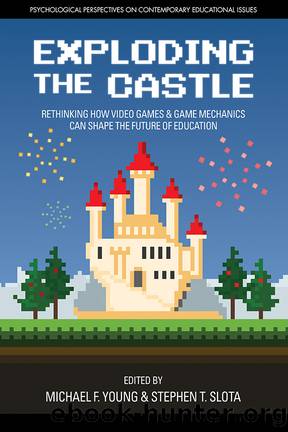IA1653-Young by Unknown

Author:Unknown
Language: eng
Format: epub
Published: 2017-07-05T20:30:13+00:00
Figure 7.1 Mystery of Taiga River, where youth take on role of scientist to save a park through inquiry.
Further, by leveraging embedded assessments, pedagogical scaffolds, game consequentiality, and teacher dashboards, these experiences can provide an important learning tool through which experiential learning can occur and be effectively managed by a teacher in the context of actual classrooms. Key genres of small âgâ games include, among others, (a) adventure (optimized for enabling students to take on identities and solving problem in an engaging, narrative context); (b) simulation (optimized for students to experience real-world scenarios that contextualize learning vs. optimized for pure fidelity itself); (c) strategy (optimized for students to solve complex problems balancing multiple variables to accomplish desired outcomes); and (d) toolbox (optimized for students to create content with powerful tools to realize diverse goals and develop new media literacies). The small âgâ games have proven to be particularly effective at creating high levels of student engagement and enable students to work independently (both in class and at home) with teachers able to monitor their work through a dashboard offering clear guidance as to when and how a student needs a direct engagement with the teacher (Barab et al., 2010). The design of the game itself embeds the scaffolding and feedback for students to advance at their own pace and requires critical competencies to be developed in order to finish the game.
However, small âgâ games do have limitations. They are bounded, cover a constrained range of content, and can be more difficult to optimizeâfor example, they do not always fit seamlessly into prescribed state and local class scope and sequence. Even if they do capture the goals of the local experience, they fail to be open to extensions and personalization beyond the immediate precrafted design. To help address these limitations, there is much that can be learned from the commercial game franchises, which often have significant communities and nongame service components that reach beyond the core gameplay experience. These games have expanded beyond their design experience to bring players together in affinity spaces, video tutorials, resource guides, peer mentorship frameworks, and larger communities. Through these metagame affinity spaces, players interact socially around gamesâdiscussing them, often requiring extensive reading and writing, playing them cooperatively or competitively, and even potentially modifying them.
Big âGâ Games
Metagame interactions that take place outside of the game all act as extensions of the original design, providing the game a larger life and impact than initially developed. This metagame experience is what James Paul Gee refers to as the big âG,â and it acts as a force multiplier on the engagement level of games. Big âGâ game infrastructures are open-ended and seamlessly integrate the small âgâ games into a larger, flexible âmetagameâ structure and affinity space that fosters user-driven extensions and adaptations in support of real-world goals and outcomes. It is with the big âGâ components that we transform individual experiences within a game into a dynamic social interaction to enable learning to be applied and extended beyond the classroom walls.
Download
This site does not store any files on its server. We only index and link to content provided by other sites. Please contact the content providers to delete copyright contents if any and email us, we'll remove relevant links or contents immediately.
Harry Potter and the Prisoner of Azkaban (Book 3) by J. K. Rowling(3304)
The Raven Boys by Maggie Stiefvater(3084)
The Diviners by Libba Bray(2887)
Harry Potter 3 - Harry Potter and the Prisoner of Azkaban by J. K. Rowling & Mary Grandpré(2664)
4 - Harry Potter and the Goblet of Fire by J.K. Rowling(2656)
Harry Potter and the Deathly Hallows (7) by J.K. Rowling(2641)
Lord of the Rings by J.R.R. Tolkien(2514)
Harry Potter and the Cursed Child by J. K. Rowling & John Tiffany & Jack Thorne(2035)
The Coldest Girl in Coldtown by Holly Black(2019)
The Assassin's Blade by Sarah J. Maas(1878)
The Grisha Trilogy by Leigh Bardugo(1867)
The Archived by Victoria Schwab(1833)
The Winner's Curse by Marie Rutkoski(1822)
Crown of Midnight (Throne of Glass series Book 2) by Maas Sarah J(1779)
Witch Eyes by Scott Tracey(1689)
Anna Dressed in Blood by Kendare Blake(1652)
Wraith: (Book 1) by Angel Lawson(1482)
Breaking Dawn by Stephenie Meyer(1473)
Fire and Hemlock by Diana Wynne Jones(1411)
